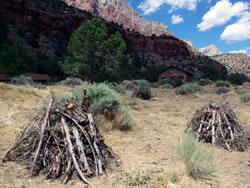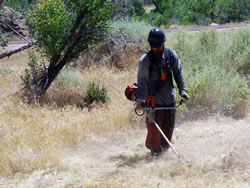National Cohesive Wildland Fire Management Strategy Success Story
Park Completes Residential Fuel Reduction Treatment Project
Zion National Park, Utah
Cohesive Strategy - Maintain and Restore Landscapes
2011

Piles ready for burning.

Creating a fuelbreak in a residential area.
Most of the fuel treatments work that has taken place in Zion over the last few years has focused on the Wildland Urban Interface along the park’s boundary. While these projects are justifiably considered priorities, some of them being identified as “focus areas” by fire management officials, the park cannot lose sight of interface areas within its own boundaries. Fire management personnel at Zion addressed this issue by recently completing a hazard fuels reduction project within the Oak Creek, Pine Creek and Watchman residential areas of the park.
The 20-acre hazard fuels reduction project consisted of the mechanical removal of material in and around park structures, many of which are considered historical, that could pose a significant fire risk in the case of a wildfire. The objective of this project was to create and maintain a defensible fuel break in and around park infrastructure within the residential areas. This project will not only aid the wildland fire crew in their efforts to manage wildfires but also the structural fire crew in their efforts to protect park buildings. This project is just one of several similar treatments planned for the next few years in areas of the park’s interface.
Wildland fire personnel began work on the project in June 2011 and completed it in August 2011. All residents were notified in advance of the project and the crew worked closely with them to try to accommodate any special needs/desires that they had, while still achieving the stated objectives of the project.
Project treatment consisted of constructing a firebreak by removing most flammable vegetation within 30-100 feet of structures. Exceptions were made for certain species and individual trees. This was accomplished with the use of mechanical equipment such as chainsaws, hand saws, rakes and brush/weed cutters. Treatments were accomplished so as to preserve the cultural landscape of the residential areas as much and as safely possible. Material removed from the project area were either piled away from the structures for future burning or taken to a local disposal site. Follow-up treatments will be necessary to maintain the desired fuels level.
With the recent push to treat more acres in the Wildland Urban Interface, some parks may be overlooking their own interface issues. These interface areas, and the structures within them, are vital to the operation of the parks and to the millions of visitors who utilize them. Plans must continue to be made to address these park interface areas and insure that they too are protected from the continuing wildfire threats.
Contact
David Eaker, Fire Communication/Education Specialist
Email: David_Eaker@nps.gov
Phone: (435) 772-7811